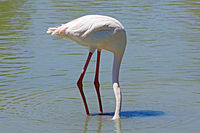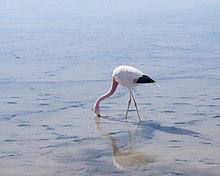Phoenicopterus
The greater flamingos (Phoenicopterus) are a genus of neognathous birds of the Phoenicopteridae family. They are birds that are distributed both in the western hemisphere and in the eastern hemisphere; there are two species in America and one in the Old World. They have a holorrhine desmognathous skull, with sixteen to twenty cervical vertebrae and anisodactyl feet.
Morphology
These are very slender birds, between 80 cm and 1.40 m long, with very long legs and a long neck. The beak is very characteristic and perfectly adapted to rummage through the mud. The upper jaw is smaller than the lower one, which is the only mobile one. The bill has a pronounced downward curvature and is equipped with internal lamellae to retain food substances when filtering the slime. The feet have four toes, the front three joined by a membrane and the rear one very small.
All the species are more or less deep pink, from the light pink almost white of the European flamingo (Phoenicopterus roseus), to the salmon color of the Caribbean flamingo (Phoenicopterus ruber ).
While flying, they keep their necks and legs fully extended.
Ecology
Requires large expanses of shallow water, usually saline, brackish, or alkaline, from sea level to 5,000 m s. no. m.. They are found on all continents except Oceania.
They make nests of mud, shaped like a truncated cone, with a concave top, where they lay a single white egg (sometimes two) that they incubate for about thirty days. Flamingos feed their young with a "milk" similar to that of pigeons, but with more fat and less protein, which is produced by glands located in the upper part of the digestive tract. The young are fed with this product for about two months, until their beak is sufficiently developed to filter the food.
Food
Flamingos are filter feeders of crustaceans and algae. Their oddly shaped beaks are adapted to separate mud from the food they eat, and they uniquely use them upside down. Food filtering is supported by filamentous structures called lamellae, small blades that are on the jaws, and a large, rough tongue.
Colour
Flamingo chicks hatch with white plumage, but the adult's feathers are bright pink to red, due to carotenoids obtained from their food. A well-fed and healthy flamingo is light pink to red in color. The pinkest flamingo is the most desirable as a companion. A pale or white flamingo is generally ill or may have suffered from a nutritional deficiency.
Taxonomy
- Living species
The genus Phoenicopterus has three living species:
- Phoenicopterus chilensisChilean flamenco, austral flamenco or parihuana, from southern South America (the most southern species of the family, both in their distribution of life and in nidification). It's the smallest species in the genre.
- Phoenicopterus roseusof Africa, Asia and Europe. It is the largest species in the genus.
- Phoenicopterus ruber (Roman or Americanflamenco), flamenco from the Caribbean, Central America and North South America.
- Fossil species
In addition to living species, numerous species were described on the basis of the fossil record alone:
- Phoenicopterus floridanus Brodkorb,1953 (Florida Early)
- Phoenicopterus stocki Miller, 1944 (Plioceno Medio de Rincón, Chihuahua, Mexico)
- Phoenicopterus copei Shufeldt, 1892 (Pleistocene Late of Oregon, West America and Central Mexico)
- Phoenicopterus minutus Howard, 1955 (Pleistocene Superior de California, USA)
- Phoenicopterus eyrensis (Late oligocene of South Australia).
- Taxonomic relations
Phoenicopterus is separated from Phoenicoparrus, among other characteristics, by presenting a quite different bill structure, since it is more primitive, only suitable for capturing larger prey, such as molluscs and crustaceans. In addition, it has a hallux, one of the toes. The structure of the bill in Phoenicoparrus is deeply keeled with a more specialized filter apparatus, bulbous in cross section suitable for capturing very small prey, such as blue-green algae and diatoms.
As the importance of these characteristics in the designation of a proper genus had been questioned, and based on what was determined by a DNA-DNA hybridization analysis published in 1990 which had found small genetic distances between all the representatives of the family, Phoenicoparrus became synonymous with Phoenicopterus.
This consideration was used until new and more complete genetic studies of all the taxa of the family using samples of twelve nuclear loci and two mitochondrial loci, generated a robust phylogenetic tree with a high level of support using the Bootstrap method of parsimony and maximum likelihood. They found a deep separation between the greater and lesser flamingos, which justified their being divided again into at least two genera, by merging the monotypic genus Phoeniconaias (with its only species: Phoeniconaias minor) in Phoenicoparrus, as it is barely distinguishable due to the missing toe of the South American parinas, although its size is reduced. This last species, like the South American parinas, was included in the genus Phoenicopterus.
The Phoenicoparrus and Phoenicopterus clades diverged in the Pliocene or early Pleistocene (1.7 to 3.9 million years ago).
Contenido relacionado
Achnatherum
Bocagea
Sapranthus







